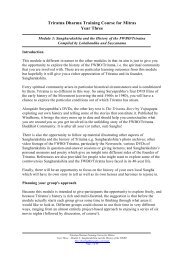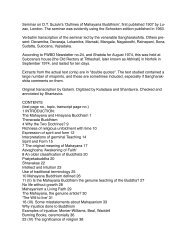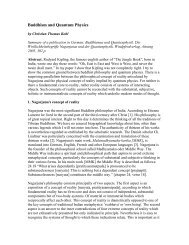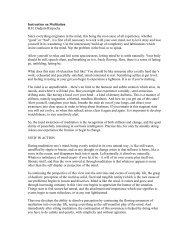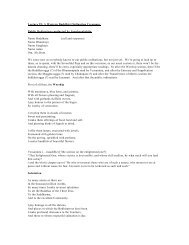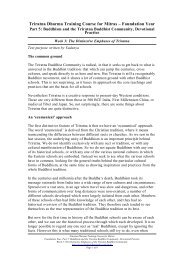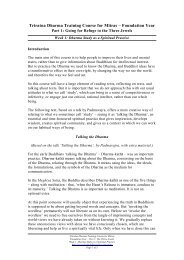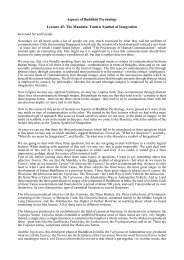Great Buddhists from Triratna Refuge Tree - Free Buddhist Audio
Great Buddhists from Triratna Refuge Tree - Free Buddhist Audio
Great Buddhists from Triratna Refuge Tree - Free Buddhist Audio
You also want an ePaper? Increase the reach of your titles
YUMPU automatically turns print PDFs into web optimized ePapers that Google loves.
on it and transform it. There are also people living in „hell without‟ to whom we<br />
need to take the Dharma, so figuratively we descend to them. We do not join them<br />
in hell, but we are confronted with their pain if we try to help them.<br />
On the lotus at the back are the books of the Dharma. I believe that in the Going<br />
for <strong>Refuge</strong> and Prostration Practice of Padmasambhava they are Tibetan texts on<br />
the back lotus. In the Śākyamuni practice they are texts of all Yānas – Hīnayāna,<br />
Mahāyāna and Vajrayāna. One can visualise those in all their different forms.<br />
They may be written on palm leaves, they may be the Tibetan books that flip over,<br />
they may be wrapped in gold cloths, or in the form of Japanese scrolls, or<br />
engraved on jade – all the variety of ways in which people have written down the<br />
Dharma.<br />
On the lotus at the left of Śākyamuni, similarly to the other practices, are the<br />
Arahants. Particularly emphasised are Ananda, who was the Buddha‟s companion;<br />
Sāriputta and Moggallāna who are great spiritual friends; Mahākassapa the great<br />
ascetic; and Dhammadinna. It is quite interesting having one‟s enlightened<br />
namesake in a visualisation practice. I read once – I do not remember where – that<br />
Dhammadinna had practised something like 19,000 years of brahmacarya before<br />
she became an Arahant, so one can make small steps in that direction! Bhante<br />
describes her in the Survey as, “Intellectually gifted.”<br />
Then we come to the sixteen Gurus of the Past, above the head of Śākyamuni.<br />
These sixteen gurus form a very interesting part of the new <strong>Refuge</strong> <strong>Tree</strong> practice.<br />
One could do years of study to find out all about them, read their life-stories and<br />
all their literature. Sometimes people say there is nothing for Order Members to<br />
study but we could have an Order study course, or even a post-Mitra study course,<br />
based on the sixteen gurus of the past. This could take us a very long time if we<br />
really absorbed their life-stories, their example, their literature, and the seminars<br />
that Bhante has led on their material. If we did this I think we would take huge<br />
leaps forward, as a Movement, in our understanding of the Dharma and our ability<br />
to communicate the Dharma to others.<br />
In the first row above Śākyamuni are the teachers <strong>from</strong> the Japanese <strong>Buddhist</strong><br />
tradition. We have Hakuin, Kukai, Dogen and Shinran. Hakuin is the founder of<br />
the modern Rinzai Zen school. Zen, or Ch‟an, came into Japan much earlier <strong>from</strong><br />
China, but Hakuin reformed and revitalised this school. He is supposed to have<br />
had a sharp mind and a great intellect and great literary gifts. He wrote poetry, and<br />
he is famous with us for his Song of Meditation. Samata found a reference to<br />
Hakuin when we were doing research, which said that his sole heritage (as a young<br />
monk, presumably) was a deserted temple. It had no proper roofs to speak of, and<br />
the stars shone through at night. Nor were there any decent floors, so it was<br />
necessary to wear gaiters and a rain hat if it rained while there were activities in<br />
the main shrine room. You can get an impression of the kind of situation he was<br />
working with, especially if you have worked on a <strong>Triratna</strong> building site! More than<br />
that – all the property that he owned was in the hands of creditors, and the priestly<br />
belongings were mortgaged to the trades-people. The quotation concludes: “Thus<br />
was his character matured.” He was very gifted, but he did not have an easy life.<br />
<strong>Triratna</strong> Dharma Training Course for Mitras<br />
Year Four, Module 7: <strong>Great</strong> <strong><strong>Buddhist</strong>s</strong> <strong>from</strong> the <strong>Refuge</strong> <strong>Tree</strong> of the <strong>Triratna</strong> <strong>Buddhist</strong> Order<br />
http://freebuddhistaudio.com/study<br />
Page 30 of 42



